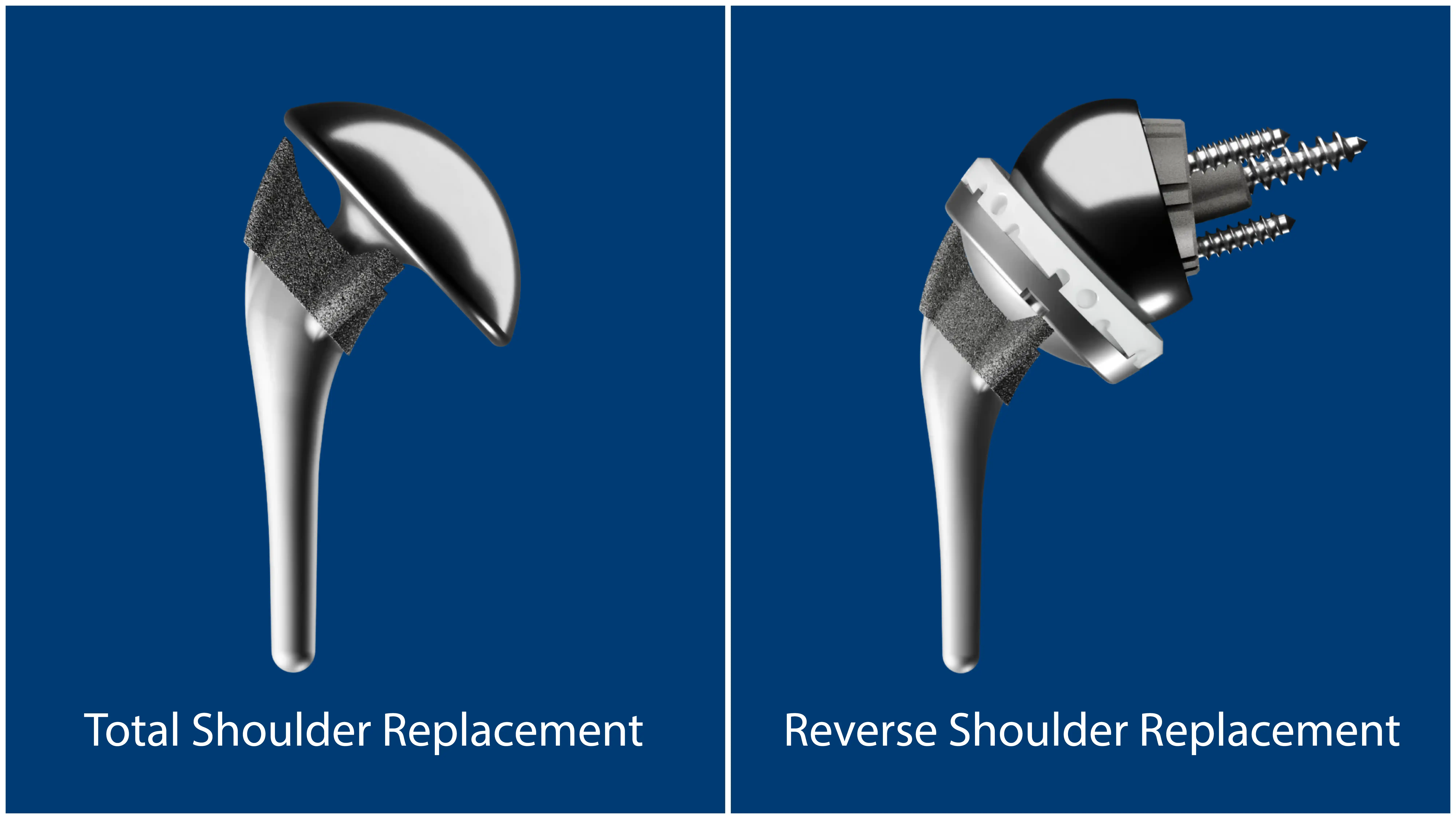Dealing with persistent shoulder pain and limited mobility? Weighing the benefits and risks of shoulder replacement surgery can help you make an informed decision. In this post, we’ll cover what shoulder replacement entails, the different types of surgeries available, recovery expectations, and realistic outcomes.
Key Takeaways
- Shoulder replacement surgery can significantly improve quality of life by alleviating chronic pain and restoring mobility for patients with severe joint damage.
- The procedure is typically considered when conservative treatments fail to relieve persistent shoulder pain and mobility issues, especially in cases of advanced arthritis or severe injuries.
- While the surgery generally enhances mobility and daily comfort, potential complications like infection or nerve damage require careful discussion with an experienced orthopedic surgeon.
Understanding Shoulder Replacement Surgery
Shoulder replacement surgery, also known as shoulder arthroplasty, involves removing damaged bone and cartilage and replacing them with artificial implants made of metal, plastic, or ceramic. These implants are designed in various shapes and sizes to meet each patient’s anatomical needs.
Common reasons for shoulder replacement surgery include severe shoulder pain, inflammation, and loss of mobility caused by conditions like arthritis, rotator cuff tears, and fractures. For those suffering from chronic shoulder pain, shoulder replacement surgery can dramatically improve quality of life by restoring function and reducing discomfort.
Evaluating the Need for Shoulder Replacement
Shoulder replacement surgery is typically considered when conservative treatments fail to alleviate shoulder pain and mobility issues disrupt daily activities. Conditions like advanced osteoarthritis, rheumatoid arthritis, or posttraumatic joint damage can lead to severe deterioration of the shoulder joint, making surgery a viable solution.
Patients experiencing unrelenting shoulder pain, inflammation, and stiffness should consult a shoulder specialist to determine if shoulder replacement surgery is the right step.
Persistent Pain and Limited Mobility
Chronic shoulder pain and restricted movement can have a significant impact on daily life. Osteoarthritis, the most common type of shoulder arthritis, causes the gradual breakdown of shoulder joint cartilage. As the cartilage in the shoulder joint wears away, bone-on-bone contact can create persistent pain and stiffness, turning routine tasks like reaching for heavy objects or dressing into challenges.
Ineffectiveness of Conservative Treatments
Rest, ice, physical therapy, and pain medications are often the first line of defense against shoulder pain. For some patients, these conservative treatments are enough to provide relief. However, if pain persists and limits independence over several months, shoulder replacement surgery may be recommended.
Types of Shoulder Replacement Surgeries
The two main surgical options are anatomic total shoulder replacement and reverse total shoulder replacement, each with a unique approach and benefits tailored to the patient’s condition.
Anatomic total shoulder replacement replaces the ball-and-socket joint of the shoulder with artificial implants, aiming to restore the shoulder’s natural shape and function, including the humeral head. This is a common choice for those with intact rotator cuff muscles.
Reverse shoulder replacement, designed for patients with severe rotator cuff damage, reverses the ball-and-socket structure to rely on different muscles for movement.

Total Shoulder Replacement
Total shoulder replacement surgery involves four key steps:
- Pre-operative preparation
- A surgical incision
- Removal of damaged bone
- Implantation of the new joint
This procedure is particularly effective for patients with severe arthritis or other joint damage where the rotator cuff muscles are still functional. The prosthetic components are engineered to mimic the natural shoulder joint, aiming to provide pain relief and restored mobility through durable, long-lasting implants.
Reverse Shoulder Replacement
Reverse shoulder replacement surgery is a specialized procedure for patients with rotator cuff damage. Unlike traditional shoulder replacements, this surgery reverses the ball-and-socket structure of the shoulder joint, attaching the ball to the shoulder blade and fitting the socket to the arm bone.
This reversal changes the joint mechanics, allowing the deltoid muscle to compensate for the damaged rotator cuff muscles. This surgery is particularly beneficial for patients with conditions like rotator cuff tear arthropathy, where the rotator cuff tendons are severely compromised.
The Procedure: What to Expect
Preparing for shoulder replacement surgery often involves following specific pre-surgery instructions regarding hygiene, dietary restrictions, and medication adjustments. Your surgical team will likely conduct X-rays and CT scans to assess the shoulder joint and create a personalized surgical plan based on your unique shoulder anatomy.
The procedure itself typically takes 1 to 2 hours and uses general anesthesia to keep the patient unconscious and pain-free. During the surgery, an incision is made, muscles are gently detached, and the surgeon removes the damaged bone and cartilage. The new implants are then placed and secured, and the muscles are reattached to the bones.
Post-surgery, patients are monitored for vital signs and pain levels in the recovery room before discharge, with most patients discharged either the same day or after an overnight observation period.
Post-Surgery Recovery and Rehabilitation
Recovery from shoulder replacement surgery generally takes a few months, with most patients returning to normal activities within three to six months. During the initial recovery phase, for about four to six weeks, patients are usually advised to wear a sling and may require assistance with daily tasks.
Throughout the recovery process, structured physical therapy supports patients in regaining their range of motion and strength. A physical therapist can guide patients through exercises specially designed to facilitate healing and restore function. To prevent complications, patients should avoid intense activities like heavy lifting or sports until cleared by their care team.
Pain Management
A well-planned medication regimen, often involving a combination of pain relievers and anti-inflammatory drugs, can significantly relieve pain and facilitate a smooth recovery. Nerve blocks administered during surgery can also help manage postoperative pain in the initial stages.
Patients should closely follow their prescribed treatment plan for pain management and communicate with their care team for treatment adjustments if needed.
Physical Therapy and Exercises
Physical therapy typically begins a few weeks after shoulder replacement surgery. Initially, therapy focuses on small wrist and elbow movements to enhance range of motion without straining the shoulder. As recovery progresses, patients move on to more active exercises like shoulder shrugs and lightweight lifts.
This gradual increase in activity helps rebuild strength and flexibility in the shoulder joint, with the ultimate goal of the patient returning to normal activities.
Weighing the Benefits
Shoulder replacement surgery can deliver transformative benefits for eligible patients. The primary goal is to alleviate chronic, debilitating pain, allowing patients to regain their quality of life. Most patients who undergo this surgery report reduced pain, improved range of motion, and increased strength.
Beyond these physical benefits, many patients experience improvements in overall life satisfaction and happiness, as they can return to the activities they enjoy.
Improved Mobility
The restoration of movement represents one of the procedure’s most impactful benefits. After shoulder replacement surgery, many patients typically experience a significant reduction in pain and stiffness. Tasks that were once challenging, like reaching overhead or lifting objects, become more manageable. This improved mobility fosters a sense of independence and allows patients to engage more fully in day-to-day activities.
Enhanced Quality of Life
The benefits of shoulder replacement surgery extend beyond physical improvements. With reduced pain and restored function, patients often experience quality-of-life improvements. Patients can usually return to recreational and social activities they may have given up due to shoulder pain. This return to normalcy often carries profound implications for mental health, social connectedness, and overall happiness.
Considering the Risks
As with all surgical procedures, shoulder replacement surgery carries risks. Infection is a concern and can lead to severe complications if not addressed promptly. Nerve damage, particularly to the axillary nerve, can occur during surgery, resulting in varying degrees of shoulder weakness or loss of sensation.
Other potential complications include joint dislocation, blood clots, and aseptic loosening of the prosthetic joint, which can affect the longevity of the shoulder replacement. Patients with systemic infections or certain health conditions may not be suitable candidates for surgery.
Discussing these risks with an orthopedic surgeon and taking proactive measures to minimize risks can reduce the likelihood of needing revision surgery.
Making an Informed Decision
An experienced orthopedic surgeon who specializes in shoulders can help you determine if surgery is the right option for you. Factors like age, body mass index, overall health, and personal goals will be considered.
For patients who have exhausted non-surgical options, shoulder replacement often provides pain relief and functional improvement. Many patients with chronic shoulder pain and mobility issues report wishing they had undergone the procedure sooner.
Summary
Shoulder replacement surgery can be a life-changing procedure for those suffering from chronic shoulder pain and limited mobility. By understanding the different types of surgeries available, what to expect during the procedure, and the recovery process, patients can make informed decisions about their healthcare. While there are risks involved, the benefits of pain relief, improved mobility, and enhanced quality of life often outweigh these concerns.
Ultimately, consulting with a shoulder specialist and thoroughly evaluating all options can lead to a decision that significantly improves your overall well-being and allows you to return to the activities you love.
Frequently Asked Questions
What is shoulder replacement surgery?
Shoulder replacement surgery, or shoulder arthroplasty, is a procedure that removes damaged bone and replaces it with metal and plastic implants to relieve pain and improve mobility. This can significantly enhance the quality of life in patients suffering from severe shoulder pain.
When should I consider shoulder replacement surgery?
You should consider shoulder replacement surgery when conservative treatments have not relieved severe shoulder pain and your daily life is impacted. It’s essential to discuss your condition thoroughly with your doctor to determine the right timing for surgery.
What are the types of shoulder replacement surgeries?
The two main types of shoulder replacement surgeries are anatomic total shoulder replacement and reverse total shoulder replacement, each tailored to meet specific medical conditions and patient needs.
What can I expect during the recovery process?
You can expect the recovery from shoulder replacement surgery to take a few months, typically involving the use of a sling for four to six weeks and engaging in physical therapy to restore your range of motion and strength.
What are the potential risks of shoulder replacement surgery?
Shoulder replacement surgery carries potential risks such as infection, nerve damage, joint dislocation, blood clots, and aseptic loosening of the prosthetic joint. It’s important to discuss these risks with your orthopedic surgeon to ensure informed decision-making.



